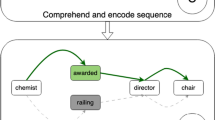Abstract
Studies of working memory demonstrate that some forms of information are retrieved by a content-addressable mechanism (McElree & Dosher, 1989; McElree, 1996, 1998), whereas others require a slower search-based mechanism (McElree & Dosher, 1993). Measures of the speed and accuracy of processing sentences with filler-gap dependencies demonstrate that the probability of maintaining a representation of a filler item decreases as additional material is processed, but that the speed with which a preserved representation is accessed is unaffected by the amount of interpolated material. These results suggest that basic binding operations in sentence comprehension are mediated by a content-addressable memory system.
Similar content being viewed by others
REFERENCES
Clark, S. E. & Gronlund, S. D. (1996). Global matching models of recognition memory: How the models match the data. Psychonomic Bulletin & Review, 3, 37–60.
Dosher, B. A. and McElree, B. (1992) Memory search: Retrieval processes in short-term and long-term recognition. In Larry Squire (Ed.), Encyclopedia of learning and memory (pp. 398–406). New York, Macmillian.
Gazdar, G., Klein, E., Pullum, G. K., & Sag, I. A. (1985). Generalized phrase structure grammar. Oxford: Basil Blackwell.
Gillund, G. & Shiffrin, R. M. (1984). A retrieval model for both recognition and recall. Psychological Review, 91, 1–67.
Gronlund, S. D., Edwards, M. B., and Ohrt, D. D. (1997). Comparison of the retrieval of item versus spatial position information. Journal of Experimental Psychology: Learning, Memory, & Cognition. 23, 1261–1274.
Hintzman, D. L. (1984). MINERVA2: A simulation model of human memory. Behavior Research Methods, Instruments, & Computers, 16, 96–101.
Judd, C. M., & McClelland, G. H. (1989). Data analysis: A model-comparison approach. San Diego, CA: Harcourt Brace Jovanovich.
Lewis, R. (1996). Interference in short-term memory: The magical number two (or three) in sentence processing. Journal of Psycholinguistic Research, 25, 93–115.
McElree, B. (1993). The locus of lexical preference effects in sentence comprehension: A timecourse analysis. Journal of Memory and Language, 32, 536–571.
McElree, B. (1996). Accessing short-term memory with semantic and phonological information: A time-course analysis. Memory & Cognition, 24, 173–187.
McElree, B. (1998). Attended and non-attended states in working memory: Accessing categorized structures. Journal of Memory & Language, 38, 225–252.
McElree, B., & Dosher, B. A. (1989). Serial position and set size in short-term memory: Time course of recognition. Journal of Experimental Psychology: General, 118, 346–373.
McElree, B., & Dosher, B. A. (1993). Serial retrieval processes in the recovery of order information. Journal of Experimental Psychology: General, 122, 291–315.
McElree, B., & Griffith, T. (1995). Syntactic and thematic processing in sentence comprehension: Evidence for a temporal dissociation. Journal of Experimental Psychology: Learning, Memory, and Cognition, 21, 134–157.
McElree, B., & Griffith, T. (1998). Structural and lexical constraints on filling gaps during sentence processing: A time-course analysis. Journal of Experimental Psychology: Learning, Memory, & Cognition, 24, 432–460.
McElree, B., & Nordlie, J. (in press). Literal and figurative interpretations are computed in equal time. Psychonomic Bulletin & Review, 6, 486–494.
McElree, B., Foraker, S., & Dyer, L. (in preparation) Content-addressable memories subserve language processing.
Murdock, B. B. Jr. (1982). A theory for the storage and retrieval of item and associative information. Psychological Review, 89, 609–626.
Pollard, C. & Sag, I. A. (1994). Head-driven phrase structure grammar. Chicago, IL: The University of Chicago Press.
Sternberg, S. (1975). Memory-scanning: New findings and current controversies. Quarterly Journal of Experimental Psychology, 27, 1–32.
Swinney, D., Ford, M., Bresnan, J., & Frauenfelder, U., (1988). Coreference assignment during sentence processing. In M. Macken (Ed.), Language structure and processing. Stanford, CA: CSLI.
Wickelgren, W. A. (1977). Speed-accuracy tradeoff and information processing dynamics. Acta Psychologica, 41, 67–85.
Wickelgren, W. A., Corbett, A. T. & Dosher, B. A. (1980). Priming and retrieval from shortterm memory: A speed-accuracy tradeoff analysis. Journal of Verbal Learning and Verbal Behavior, 19, 387–404.
Author information
Authors and Affiliations
Rights and permissions
About this article
Cite this article
McElree, B. Sentence Comprehension Is Mediated by Content-Addressable Memory Structures. J Psycholinguist Res 29, 111–123 (2000). https://doi.org/10.1023/A:1005184709695
Issue Date:
DOI: https://doi.org/10.1023/A:1005184709695




